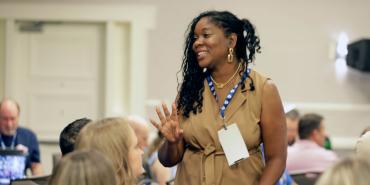Sam the Science Bot will answer all your questions. The order of the planets? Check. Earth’s age? Check: Sam pegs it at 4.5 billion years. What makes a bath bomb fizz? Also check: carbon dioxide gas, says Sam. Then he follows up: “What’s a good way to remember the planets’ order?” But ask about The Great Gatsby, and Sam nudges you back: “I’m here to help you with science. Is there a science topic in the 1920s you’d like to explore?”
Sam—a child‑friendly artificial intelligence chatbot built by United Federation of Teachers member Tiffany Jefferson—took center stage in a packed session at the AFT TEACH conference on July 25, illustrating how to integrate AI responsibly in K‑12 classrooms. Jefferson and co‑facilitator Erinn VanderMeer of the Petaluma Federation of Teachers organized the session around a four‑stage, gradual release of responsibility model for classroom use of AI: Teachers use AI first, then guide students, facilitate student‑to‑student collaboration, and finally allow independent student use. The last stage is where Sam shines—all while safeguarding privacy, safety and learning.
“When we integrate AI in the classroom, we need to start with ourselves first,” Jefferson said. “We have to start with our own learning; then we can work with our students; and eventually we can have our students use AI independently.”
Stage 1: Educators first
Jefferson urged teachers to learn by letting AI tackle “teacher stuff”―drafting emails and recommendation letters, building unit plans and generating differentiated materials. She demonstrated how Canva AI can spin up worksheets in multiple languages or differentiate them for varied learning needs. One Advanced Placement U.S. history teacher in the room said he used Google NotebookLM to turn dense chapters into podcasts, which support students as they take notes and prepare for class discussions; another teacher relies on MagicSchool to generate rubrics so students understand what they are learning and when it should be mastered. “We go to AI to create,” Jefferson said, but the teacher still curates and vets.
Stages 2 and 3: Collaborating with students—and letting them collaborate with each other
Once teachers are comfortable, they can bring AI into shared work with students and peer groups, VanderMeer explained. But three rules are non‑negotiable:
- Safety, privacy, transparency. Strip personally identifiable information from prompts, verify all AI output, be upfront when a resource is AI‑generated, and make sure parents know you’re using AI and how you are using it.
- Policy and infrastructure. Follow district rules, and confirm your IT setup can support the tools.
- Bias vigilance. VanderMeer, an art teacher, noted that when she asked AI to draw “a room full of teachers,” it produced only white men. That’s why, she said, “never generate anything for the first time in front of students.”
She also cautioned educators to always remind students: AI is a helper, not a substitute. “You’re an amazing human,” VanderMeer tells her classes. “You don’t have to give your future to a keyboard, but you do need to know what this tool is and how to use it.”
Stage 4: Independent student use
The final step—best suited to older students—is letting them use AI on their own. Jefferson walked attendees through building a student‑friendly chatbot: Define a persona (the room voted for “dad‑joke teller”), spell out acceptable outputs so answers come back at the right level and tone, and set clear boundaries for behavior. (“What happens if a student curses at the bot?”)
By the session’s end, participants had a road map, examples and guardrails: Start small, model often and release responsibility gradually. The presenters’ closing message underscored balance.
“Just using AI technology for everything isn’t enough—you still have to use your mind,” VanderMeer said. “We need that balance in our classrooms.”
In other words, AI can spark imagination and save time, but human creativity, judgment and ethics still run the show.
[Melanie Boyer]

